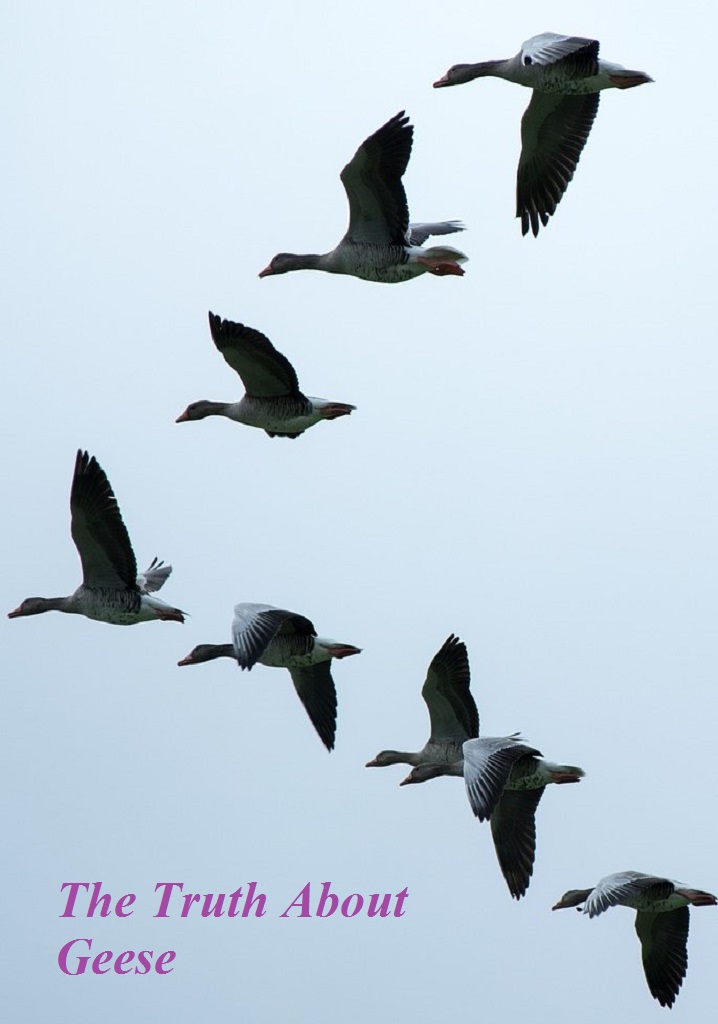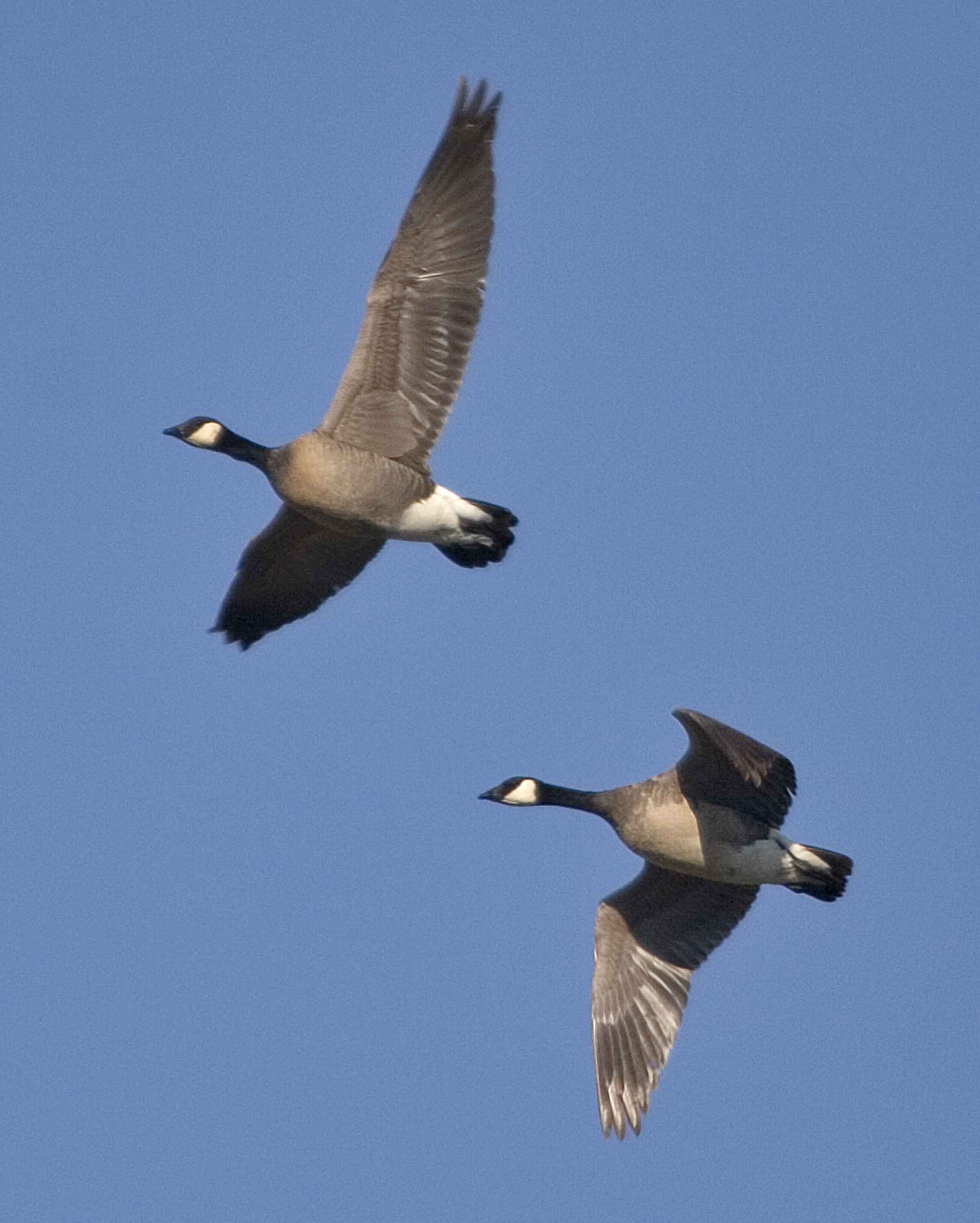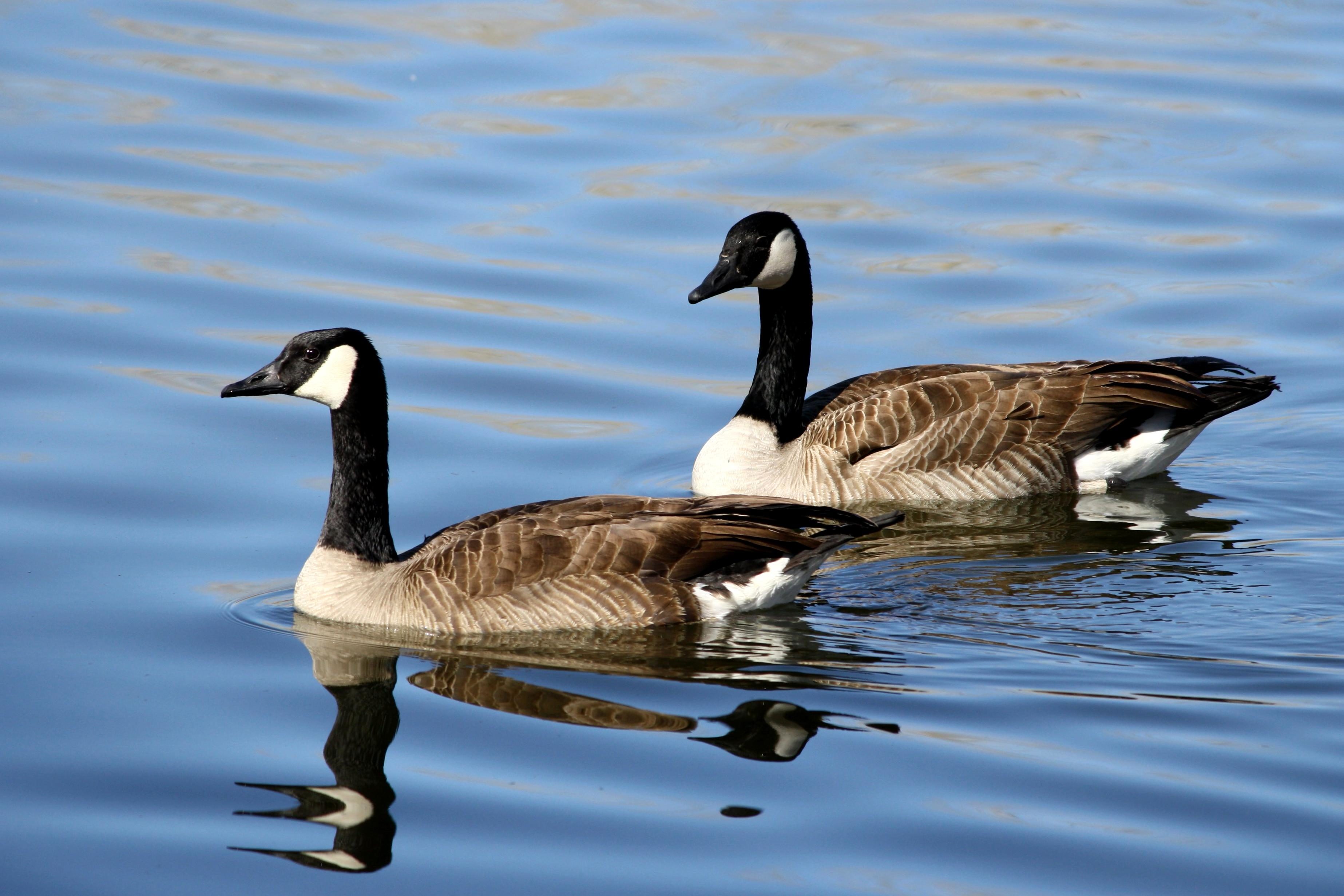The Truth About Geese
 Some years back a long-term study of the behaviour of a flock of migratory Canadian Geese was carried out and, over that period, the researchers discovered some amazing characteristics about these (seemingly) simple creatures, and their habits.
Some years back a long-term study of the behaviour of a flock of migratory Canadian Geese was carried out and, over that period, the researchers discovered some amazing characteristics about these (seemingly) simple creatures, and their habits.
Most people are aware of the classic “V” formation in which the geese fly when travelling together. This is something that military airforces have adopted throughout the world. So what is the purpose of this formation? It’s very simple, each of the geese, or the planes following the leader fly either slightly below or above the one in front. In doing this, each member of the flight can see the leader and follow his path. Of course, with the invention of the radio, we humans have the advantage of being able to communicate in this way as well. Funnily enough, the geese communicate with the audio too. The next time a flock of geese flies over you just listen carefully and you will hear them “cackle” to one another. The researchers found that this communication between the geese served two purposes. The first sound would emit from the lead goose and was to inform the trailing members of the flock that a change of direction was happening. The second emission would usually come from some, if not all, of these trailing geese and was communicating that they were both still behind the lead goose, and had heard what was being communicated. This may seem difficult to believe, but when the researchers listened to the audio communications, they found it to be a two-way communication and not just the making of noise. There were different sounds and even different emphases. It became obvious that, as with many animals, they have their own language.
The study observed a particular flock of geese migrating from their northern home in Canada to their southern home, in this case, in Florida. As a side note, Canadian geese are often referred to as “snowbirds”. And this is where the term came from when referring to people who move from the north of the American continent to the south where they spend the winter. Mimicking the journey of the geese. (Who says we cannot learn from nature.)
The journey from Canada to Florida covers thousands of miles and, just like we humans, the geese stop for rest and food. It was found throughout this study that the geese not only did this but also stopped and fed in the same places each time they travelled. We too tend to do the same thing: stop in the same town, stay at the same hotel, and eat at the same restaurants. We have learned where we are safe, fed to our satisfaction, and able to rest in a suitable place. But, the study discovered that when the flock continued on its journey, the lead goose was a different bird from the previous one that had been leading. As the study progressed, it was also discovered that the bird which was closely following the lead goose had also changed. That bird would be what we would perhaps call “the wingman”.
To discover the reason for this, the researchers identified and captured both the lead goose and the wingman that had taken over at the second stage of the journey and hid them from the flock before the next time the geese flew south. They again stopped at the same place, resting and feeding, but when it was time to begin the second stage of their journey, now, with the absence of the (second) lead goose and its wingman, the flock rose into the air but all they did was to fly in circles. The conclusion was that there was no other goose to lead the flock in the second stage. Further study of this, and at various other stages of the journey, confirmed this theory.
In addition to this, the researchers took the study even further. Instead of taking away both the lead goose and the wingman, they just captured and removed the lead goose from the flock. What the researchers discovered was that, when the flock rose into the air at what was the beginning of the second stage of the journey, they did not fly in a circle. The “wingman” took over and became the new lead goose. It was also found that this previous “wingman” led the flock perfectly to the next resting place. Again the same experiment was repeated during different stages of the journey, and these also concluded with the same result. The wingman knew that particular part of the journey. It was the “backup navigator” becoming the new lead goose for the flock. Although the researchers never progressed any further with this particular experiment, they did observe that a different goose took the place of where the wingman flew in formation. The conclusion was that this “new” wingman was learning the route for that particular stage of the journey. In this, the flock would never be without a leader to guide them on their journey.
Further observations of the flock’s manner and habits also highlighted a very beautiful part of the nature of the geese.
Whenever a goose dropped out of formation it was found that the bird was either injured or too weak, perhaps even too old to go further,  an amazing thing occurred. At least two more geese followed that bird down. These other two birds stayed close by and were even observed bringing food to the one who has dropped out of the formation. They stayed with that fallen bird until one of two things occurred; until that bird rose and continued on the journey, or died at that place. If it did rise into flight again, the other two followed behind it. They could watch it easier from there. If that bird died, the other two took up the journey again, one leading the other.
an amazing thing occurred. At least two more geese followed that bird down. These other two birds stayed close by and were even observed bringing food to the one who has dropped out of the formation. They stayed with that fallen bird until one of two things occurred; until that bird rose and continued on the journey, or died at that place. If it did rise into flight again, the other two followed behind it. They could watch it easier from there. If that bird died, the other two took up the journey again, one leading the other.
Yet another beautiful thing about these creatures is the fact that they are entirely monogamous. When they mate, they mate for life. When they go through things they are always together. And each of the pair will ferociously defend the other if either ever come under attack. In the unfortunate event that either should die, the remaining partner never looks for a new mate. Although it would usually stay with its flock, or rejoin it later, it would likely stay in the safety of its community. It would never be alone, it would be a part of the family.
So what can we, as Christians, learn from these simple geese?
There is much that we can learn and, as with all lessons of the Lord has provided for us, we can choose to learn and incorporate those lessons into our lives, or we can ignore them and go our own way.
To give you some food for thought here are a few things you might like to consider as lessons from the geese:
It was proved that the flock needed a leader so that they could continue on their journey. It was also revealed that other members of the flock became the lead goose when a particular point of that journey was reached. There was no single goose that had all of the information or experience to lead the flock throughout the entire journey. Although there may be a senior minister, it would be very rare if he or she were entirely capable of carrying out all the needs of the ministry. Whilst there must be a leader within every ministry who has the calling on their lives and who truly receives direct instructions from the true head of the church, the Lord himself, it does not mean that that leader cannot employ the skills and talents of the flock. For example, if there is a need for a skilled tradesman to carry out work for the ministry, the senior minister, the leader can employ the skills of such a tradesman, allowing that tradesman to carry out the necessary work. But, about the ministry itself, it remains the overall responsibility of the senior person within that ministry to supervise any work or task that arises. The one major difference, in this example, between a ministry and a flock of geese is the fact that the ministry has to have properly qualified leadership because, as we’ve seen with the geese when leadership is removed there can be no progress. The journey cannot be effectively completed. In our example here the tradesman becomes the “lead goose” for the period within which his skills and or talents are required, but beyond that, they do not assume the overall, continued leadership of that ministry.
Many mistakes are made by churches where the competence of a person in one specific area is taken as the ability or even as a God-given appointment to lead that community. Most situations like this often result in a dictatorial ministry that produces both false doctrines and a “storehouse” that is empty, a church or ministry that is dead or dying. Most of us have either experienced or know of churches or ministries that have failed because of either bad leadership, or unqualified leadership, which are the results of man-made appointments and not the divine appointment of God. There have been many instances of so-called churches, or so-called ministries that rise very quickly, reach a peak, usually recruiting large congregations or memberships, and then collapsing them in this way.
Regardless of what some people might believe, humans are “herd creatures”. Very few people survive well from being alone. So when these organizations come along they so often attract people who are looking to belong, to be cared for, to be taught how, and sometimes simply just to be genuinely loved for who they are, they can become vulnerable.
Part of the truth about geese is that they are a community, a family. In so many ways they work together; they work and care for their family members. You will never find a goose cheating on its mate. You will never hear a goose lie to, or steal from its family. You will never see a goose back down in adversity leaving its mate to cope alone. You will never see a goose beat its offspring, nor that of another member of the family. You will see them correct a young one, but never to the point of physical harm.
As we’ve seen, there is much to learn from even simple creatures like the geese and the Lord has provided so many examples of what He not only desires for us, His children but of us, as His children, as His family. Simply undying love for one another, even the sinner and the unsaved.
On a personal note, I was privy to observe a pair of geese who would visit a small church I was serving in Florida. The church stood on the edge of a lake and there was a pair of geese that had nested there. People fed the geese and the birds would come out of the water searching for food. Unfortunately, there was a busy road in front of the church building and the inevitable happened……

One of the birds was knocked over and died. It lay on the side of the road, on the small grass verge, where somebody had the decency to lay it. The surviving goose stayed with its deceased partner for some three days, regardless of its danger and vulnerability. People offered food, but it would not feed, they tried to move it away from danger but it just returned to its partner’s side. Then one day it just got up, left and, to the best of my knowledge never returned. In itself, this is a sad thing, but what I believe I saw was grieving, and then moving on with life when it was time to do so. The Bible tells us in the third chapter of Ecclesiastes that there is a time for every purpose under heaven….There are many instances and examples of animals grieving for their mate or companion, and although this is just another example of it, it reveals grief as a part of life, as a part of any loss; yet it also encourages us to continue. When your life on this Earth continues after a time of grief, know that there is still work for you to do. The Lord has not finished with you yet. Your purpose is not yet fulfilled. Return to your flock and go on with God’s will for your life. Remember, that you are part of a flock; and without you in it, that flock is a lesser thing. But, if you are not part of a flock you must fulfil God’s will for your life, by seeking one out. Check to see that the ministry or church operates in the manner which the Lord has laid out in the Bible. If it does, then you have found your flock. If it does not, then move on.
As a simple guideline, you can look at Malachi 3:10 – “Bring ye all the tithes into the storehouse, that there may be meat in mine house……” Now, although this Scripture is talking about tithing, the Lord is saying here bring (your tithes) into the storehouse and specifically talks about meat, or food, in my house. Stepping aside from just focusing on the tithes, the Lord is saying that His house is a storehouse where food (meat) is stored. And, a storehouse is a place where you go for food. Obvious. So, if you are searching for God’s food, His Word, His ways and the benefits of receiving from Him, you have to go to a storehouse where it is stored. You will know whether or not the food, the Word and the doctrine that is being proffered are accurate if you will trust in the Lord and ask Him. Just like you know the difference between a rotten apple and if a fresh one. Let the original “Lead Goose” guide you. Become His wingman, go in the way that He leads and your journey will be easy, and you will accomplish what you were born to fulfill. There may even be a time when He asks you to become a lead goose. By then, you will know and understand what Jesus meant by saying, ” I am the way, the truth, and the life: no man cometh unto the Father, but by me.”
If you are experiencing being called upon, do not ignore it. You have a purpose for which only you have the ability to fulfill. The Bible teaches in Romans 10:14 –
How then shall they call on him in whom they have not believed? and how shall they believe in him of whom they have not heard? and how shall they hear without a preacher?
If you feel that you may have a calling upon your life or you simply want to have a deeper understanding of what it means to be a student of the Lord, we are very honoured to be able to offer you our Systematic Discipleship Program. It is designed to take the student from the very basic studies through to the fulfilment of the calling upon their life. Simply follow the link below and read more.